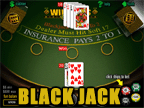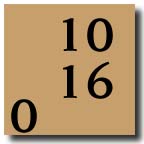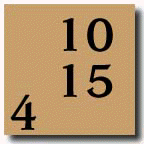|




| |

The GameMaster's Blackjack
School
Lesson 15: The Advanced Course - Part 2
Basic Strategy Variations: Hit or Stand?
The most common decision
any player makes at Blackjack is whether to hit or stand, consequently this will
be the most common basic strategy variation and you should learn all the
important ones. The first is with a hand of 16 against
a dealer's up card of 10. You should stand if the count is over 0 and hit if it
is 0 or lower. This means that if the running count is 1 or higher, stand. Since
the 'decision' number is 0, it's not necessary to calculate the true count --
the running count will do in this situation. Don't get confused here. Almost all
basic strategy variations rely on the true count, but for those where the
decision number is 0, the running count will suffice.
The next most important hand is
15 against a dealer's 10. The decision number is a true count of 4, if you are
playing at a game of four decks or more. This variation and the others can be
easily learned if you make a set of flashcards. They needn't be fancy or
sophisticated; merely accurate. Cut some 2'" squares from manila folders and
they'll work just fine. A typical flashcard should look like this.
 If you imagine the 10 and 16 placed on the centerline of a 2" X 2" square, the 0
is offset so your left thumb covers the number. As you go through the stack,
recite "sixtten versus 10, stand at zero" (or higher). For a hand of 15 vs. 10,
a card will look like this
If you imagine the 10 and 16 placed on the centerline of a 2" X 2" square, the 0
is offset so your left thumb covers the number. As you go through the stack,
recite "sixtten versus 10, stand at zero" (or higher). For a hand of 15 vs. 10,
a card will look like this
 When you come to this card, you'll recite "15 versus 10; stand at 4". As time
goes on, you won't need to remind yourself that you should stand with the 15
against 10, so you'll recite "15 versus 10 is 4". Got the idea? If you don't,
please
e-mail me and
I'll get back to you as soon as possible. Here are the numbers you'll need to
learn. These may vary a bit from numbers you'll see published in books like
Stanford Wong's "Professional Blackjack" because the ones I use are specifically
for a six-deck game where the dealer stands on A-6 and a few have been modified
based upon the theory of 'risk averse' play which was developed about 15 years
ago. These numbers work well; they have been proven in thousands of hours of
actual casino play by me and my students. Do NOT use them for single-deck games,
however. Single-deck play requires different numbers and will be covered in a
future lesson.
When you come to this card, you'll recite "15 versus 10; stand at 4". As time
goes on, you won't need to remind yourself that you should stand with the 15
against 10, so you'll recite "15 versus 10 is 4". Got the idea? If you don't,
please
e-mail me and
I'll get back to you as soon as possible. Here are the numbers you'll need to
learn. These may vary a bit from numbers you'll see published in books like
Stanford Wong's "Professional Blackjack" because the ones I use are specifically
for a six-deck game where the dealer stands on A-6 and a few have been modified
based upon the theory of 'risk averse' play which was developed about 15 years
ago. These numbers work well; they have been proven in thousands of hours of
actual casino play by me and my students. Do NOT use them for single-deck games,
however. Single-deck play requires different numbers and will be covered in a
future lesson.
Basic Strategy Variations:6 decks, dealer stands on A-6
| 12 vs. 2 |
Stand at 3 or higher |
| 12 vs. 3 |
Stand at 2 or higher |
| 12 vs. 4 |
Stand at 0 or higher |
(Yes, if the running count is at all
minus, you hit 12 against a 4.It drives the other players at the table
crazy!!!) |
| 12 vs. 5 |
Stand at -1 or higher |
(This means you hit if the count is LOWER
than -1). |
| 13 vs. 2 |
Stand at -1 or higher |
| 14 vs. Ace |
Stand at 9 or higher |
| 15 vs. 7 |
Stand at 10 or higher |
| 15 vs. 8 |
Stand at 10 or higher |
| 15 vs. 9 |
Stand at 8 or higher |
| 15 vs. 10 |
Stand at 4 or higher |
| 15 vs. Ace |
Stand at 5 or higher |
| 16 vs. 7 |
Stand at 9 or higher |
| 16 vs. 8 |
Stand at 7 or higher |
| 16 vs. 9 |
Stand at 5 or higher |
| 16 vs. 10 |
Hit at 0 or lower |
| 16 vs. Ace |
Stand at 3 or higher |
And to finish it off, one weird
play: Stand with A-7 against Ace at 1 or higher.
Beginners:
Advanced

| |
Online Gambling Community

Search engines optimization and promotion
services
CONTACT US
MultiMedia Services
Internet Marketing
Search
Engines Promotion
Online
Advertising
Web Design
Translation
Desktop Publishing
Word Processing
Business Consulting
Business Solutions
Subscribe Mailing Lists
Bet
Gambling Casino
Gambling Casino
Players Free Games
Free Gifts
Online Casino
Online
Gamblers Magazine
Online Poker
Join Webrings
Advertising
Autos
Books
Business
Cellular Phones
Chat
Clipart
Computers
Dictionaries
Dogs
Electronics
Free
Gambling
Games
Greeting Cards
Health
Jobs
Jokes
Lyrics
Maps
Movies
mp3
Music
News
Online Dating
Promotion
Real Estate
Romania
Search Engines
Shopping
Sports
Translation
Travel
Warez
Web Design
Web
Hosting
|
![]()
![]()
![]()
![]()
![]()
![]()
![]()
